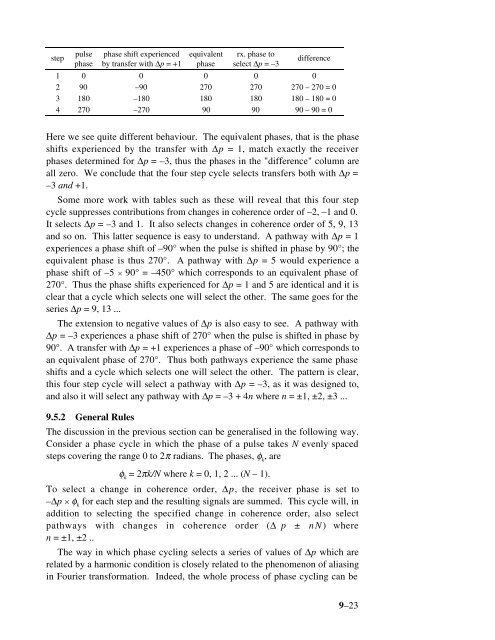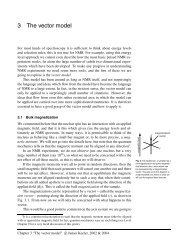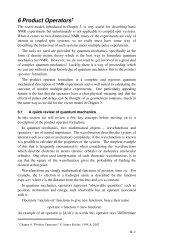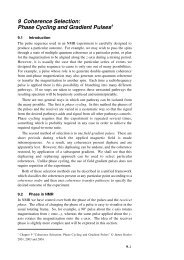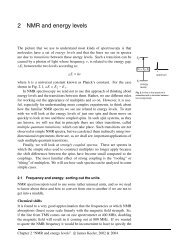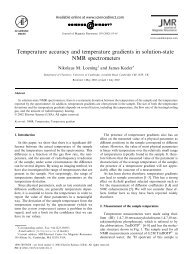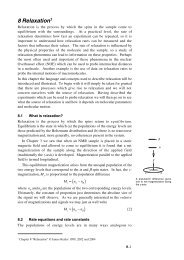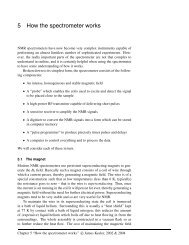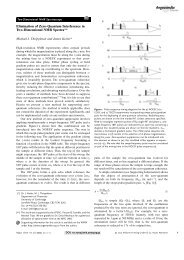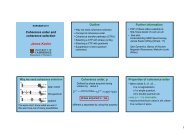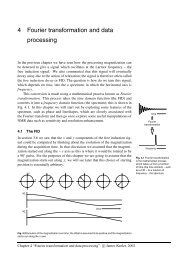Phase Cycling and Gradient Pulses - The James Keeler Group
Phase Cycling and Gradient Pulses - The James Keeler Group
Phase Cycling and Gradient Pulses - The James Keeler Group
Create successful ePaper yourself
Turn your PDF publications into a flip-book with our unique Google optimized e-Paper software.
step<br />
pulse<br />
phase<br />
phase shift experienced<br />
by transfer with ∆p = +1<br />
equivalent<br />
phase<br />
rx. phase to<br />
select ∆p = –3<br />
difference<br />
1 0 0 0 0 0<br />
2 90 –90 270 270 270 – 270 = 0<br />
3 180 –180 180 180 180 – 180 = 0<br />
4 270 –270 90 90 90 – 90 = 0<br />
Here we see quite different behaviour. <strong>The</strong> equivalent phases, that is the phase<br />
shifts experienced by the transfer with ∆p = 1, match exactly the receiver<br />
phases determined for ∆p = –3, thus the phases in the "difference" column are<br />
all zero. We conclude that the four step cycle selects transfers both with ∆p =<br />
–3 <strong>and</strong> +1.<br />
Some more work with tables such as these will reveal that this four step<br />
cycle suppresses contributions from changes in coherence order of –2, –1 <strong>and</strong> 0.<br />
It selects ∆p = –3 <strong>and</strong> 1. It also selects changes in coherence order of 5, 9, 13<br />
<strong>and</strong> so on. This latter sequence is easy to underst<strong>and</strong>. A pathway with ∆p = 1<br />
experiences a phase shift of –90° when the pulse is shifted in phase by 90°; the<br />
equivalent phase is thus 270°. A pathway with ∆p = 5 would experience a<br />
phase shift of –5 × 90° = –450° which corresponds to an equivalent phase of<br />
270°. Thus the phase shifts experienced for ∆p = 1 <strong>and</strong> 5 are identical <strong>and</strong> it is<br />
clear that a cycle which selects one will select the other. <strong>The</strong> same goes for the<br />
series ∆p = 9, 13 ...<br />
<strong>The</strong> extension to negative values of ∆p is also easy to see. A pathway with<br />
∆p = –3 experiences a phase shift of 270° when the pulse is shifted in phase by<br />
90°. A transfer with ∆p = +1 experiences a phase of –90° which corresponds to<br />
an equivalent phase of 270°. Thus both pathways experience the same phase<br />
shifts <strong>and</strong> a cycle which selects one will select the other. <strong>The</strong> pattern is clear,<br />
this four step cycle will select a pathway with ∆p = –3, as it was designed to,<br />
<strong>and</strong> also it will select any pathway with ∆p = –3 + 4n where n = ±1, ±2, ±3 ...<br />
9.5.2 General Rules<br />
<strong>The</strong> discussion in the previous section can be generalised in the following way.<br />
Consider a phase cycle in which the phase of a pulse takes N evenly spaced<br />
steps covering the range 0 to 2π radians. <strong>The</strong> phases, φ k<br />
, are<br />
φ k<br />
= 2πk/N where k = 0, 1, 2 ... (N – 1).<br />
To select a change in coherence order, ∆p, the receiver phase is set to<br />
–∆p × φ k<br />
for each step <strong>and</strong> the resulting signals are summed. This cycle will, in<br />
addition to selecting the specified change in coherence order, also select<br />
pathways with changes in coherence order (∆ p ± nN) where<br />
n = ±1, ±2 ..<br />
<strong>The</strong> way in which phase cycling selects a series of values of ∆p which are<br />
related by a harmonic condition is closely related to the phenomenon of aliasing<br />
in Fourier transformation. Indeed, the whole process of phase cycling can be<br />
9–23


